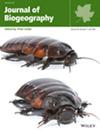Climate Predicts NDVI Better Than Plant Functional Group Attributes Along a Latitudinal Gradient in Nunavik
Abstract
Aim
This study aims to describe the latitudinal pattern in plant functional groups' (PFGs') biomass and cover in Nunavik to test whether PFG attributes are better Normalized Difference Vegetation Index (NDVI) predictors than climate.
Location
The study spans a 700-km latitudinal gradient from the lichen woodland to prostrate shrub tundra vegetation zones across Nunavik, Canada.
Taxon
Our analysis focuses on the following PFGs: erect and prostrate shrubs, herbaceous plants, bryophytes, and lichens.
Methods
Biomass and cover data of the different PFGs were sampled in 40 sites distributed across the latitudinal gradient. NDVI data were obtained through remote sensing, while climatic, permafrost depth, and surficial deposits were derived from various databases. The PFG models were built to explore relationships between average NDVI (2016–2020) at the sampling site and ecological attributes such as PFG biomass or cover but also other variables such as surficial deposits and permafrost depth. A second series of models, the climatic models, were built using only climatic variables such as seasonal temperature and precipitation.
Results
The most parsimonious PFG model was built with the biomass data of erect shrubs, herbaceous plants, bryophytes, and lichens and included surficial deposits and permafrost depth (R2 = 0.74). This biomass model performed better than the most parsimonious cover model (cover of erect shrubs and herbaceous, surficial deposits, permafrost depth; R2 = 0.63). However, the most parsimonious climatic model (fall temperature, annual, and winter precipitations) exhibited superior predictive power compared to the ecological ones (R2 = 0.87).
Conclusions
PFG models built with PFGs aboveground biomass or cover are good predictors of NDVI of the plant formations sampled along the latitudinal gradient in Nunavik. Despite the intrinsic association between NDVI and vegetation attributes, our study emphasizes the importance of the regional climate in the control of primary productivity in Arctic and subarctic ecosystems. This study provides new insights into the interpretation of NDVI data and enhances our understanding of Arctic vegetation responses under rapid climate change. Furthermore, it underscores the balance between climatic drivers and ecological dynamics in shaping fragile Arctic ecosystems.


 求助内容:
求助内容: 应助结果提醒方式:
应助结果提醒方式:


